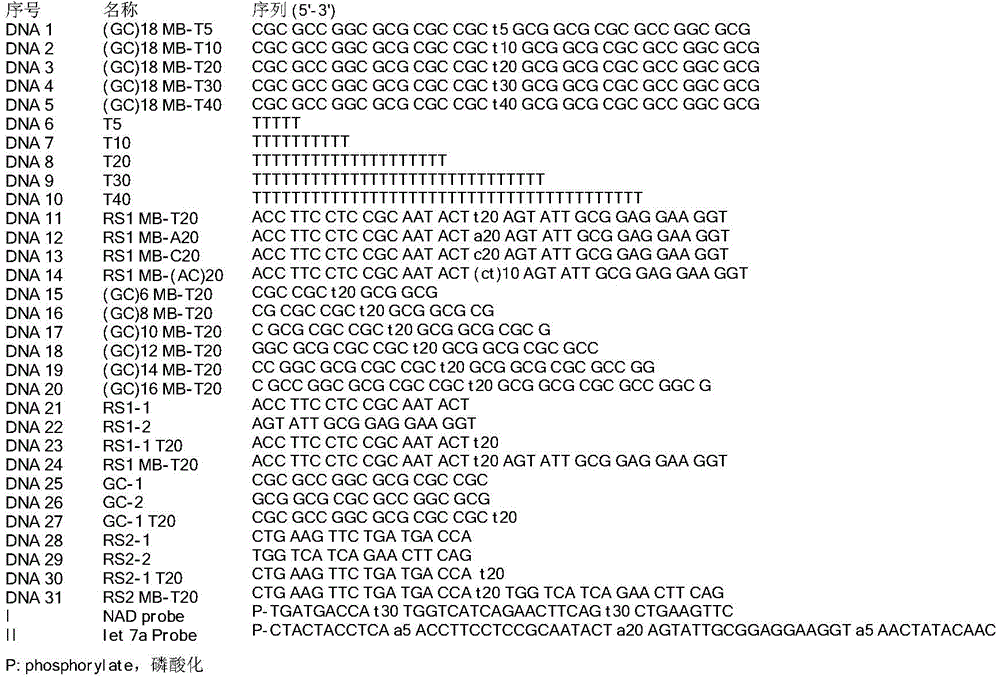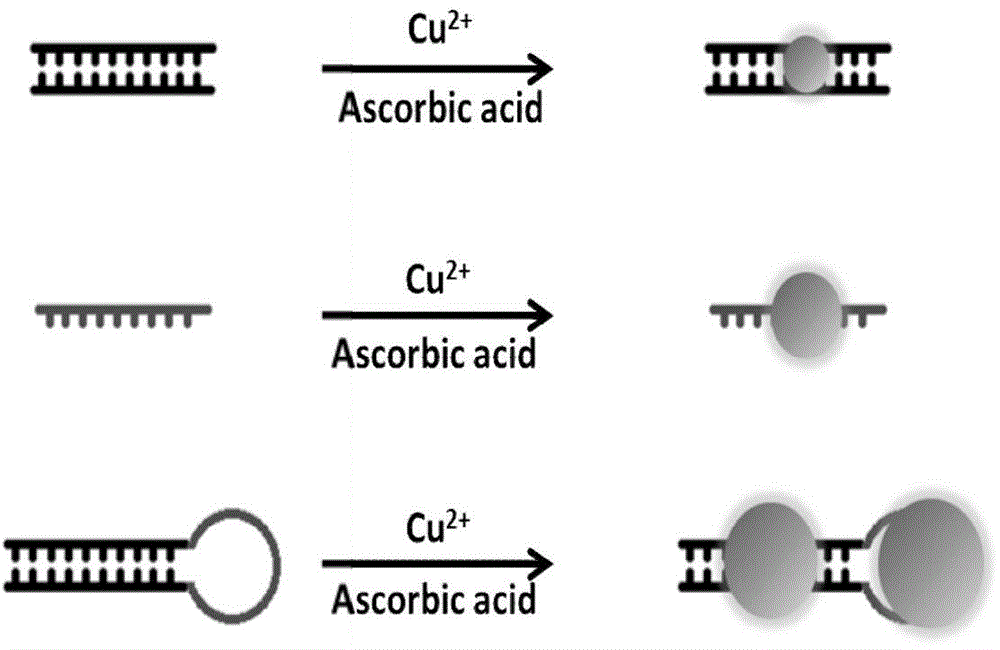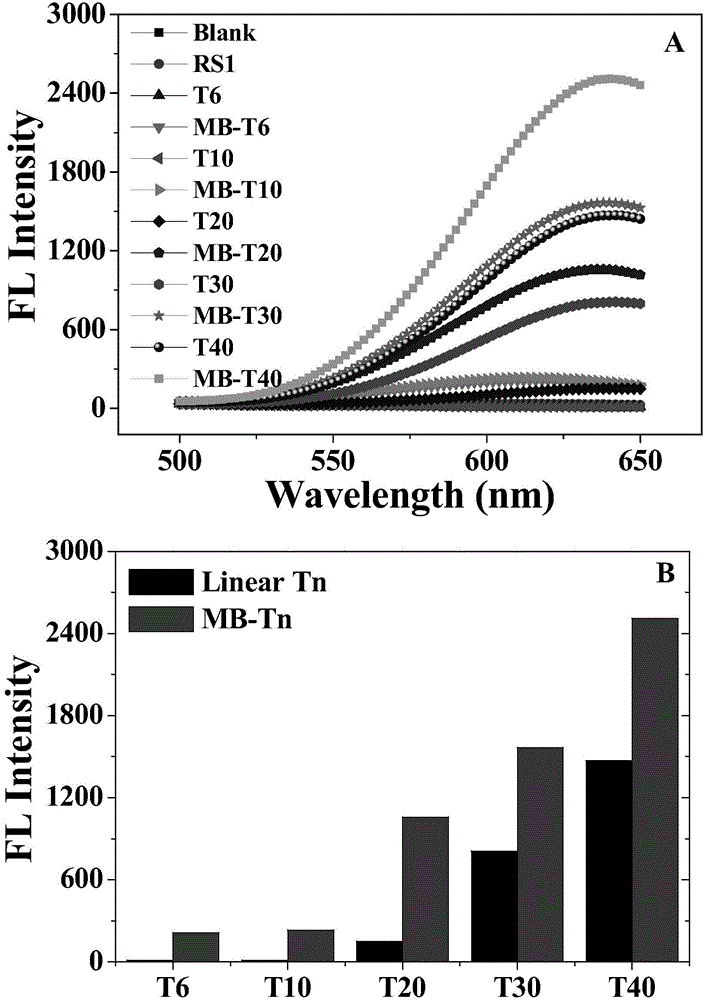Hairpin DNA template of fluorescent nano copper clusters, and applications thereof
A fluorescent nanometer and DNA sequence technology, which is applied in the direction of recombinant DNA technology, DNA/RNA fragments, microbial measurement/inspection, etc., to achieve the effects of rapid response, mild formation conditions, and high fluorescence intensity
- Summary
- Abstract
- Description
- Claims
- Application Information
AI Technical Summary
Problems solved by technology
Method used
Image
Examples
Embodiment 1
[0043] Example 1: Hairpin DNA templates form fluorescent nano-copper clusters and compare experiments with linear DNA templates
[0044] The DNA sequences used are: hairpin DNA templates with loop T numbers of 6, 10, 15, 20, 30 and 40 respectively (such as figure 1 —DNA 1-5), the stems all adopt RS1 double strands with weak ability to form fluorescent copper clusters, in addition, single-stranded linear poly T is used as a control, including T6, T10, T20, T30 and T40 (such as figure 1 — DNA6-10);
[0045] Schematic diagram of the formation of fluorescent copper clusters based on linear double-stranded templates, poly T templates and MB-Tn templates. figure 2 shown;
[0046] Take 100pmol of DNA 1-10 respectively, put them into 1.5mL EP tubes, add MOPs buffer (10mM OPs, 150mM NaCl, pH 7.0) to 194μL, then add 2μL of 10mM copper sulfate solution, 4μL of 100mM vitamin C solution, React in a shaker at room temperature for 10 minutes;
[0047] Fluorescence measurement, the excit...
Embodiment 2
[0049] Example 2: Effect experiment of the ring base of the hairpin DNA template on the formation of fluorescent nano-copper clusters
[0050] The DNA sequence used is: the hairpin DNA with T20, A20, C20 and (CT)10 in the loop, and the RS1 double strand in the stem (such as figure 1 — DNA 3, 11-13);
[0051] Take 100 pmol of the above hairpin sequence into 1.5 mL EP tubes, dilute to 194 μL with MOPs buffer, add 2 μL of 10 mM copper sulfate solution, 4 μL of 100 mM vitamin C solution, and react in a shaker at room temperature for 10 minutes;
[0052] Fluorescence measurement, the excitation wavelength is 345nm, and the emission wavelength scanning range is 500nm-650nm;
[0053] The results show that the fluorescence spectrum of the fluorescent copper nanoclusters formed by the hairpin template is as attached Figure 5 As shown, a strong fluorescent signal can be formed only when the T base is used as the loop.
Embodiment 3
[0054] Example 3: Effect of the length of the stem sequence on the formation of fluorescent copper clusters
[0055] The DNA sequences used are: the loops are all T20, the stems are GC double-stranded sequences of different lengths, hairpin DNA templates with lengths of 6, 8, 10, 12, 14, 16, and 18 bp respectively (such as figure 1 —DNA 14-20),
[0056] Take 100 pmol of the above hairpin sequence into 1.5 mL EP tubes, dilute to 194 μL with MOPs buffer, add 2 μL of 10 mM copper sulfate solution, 4 μL of 100 mM vitamin C solution, react in a shaker at room temperature for 10 minutes,
[0057] Fluorescence measurement, excitation wavelength is 345nm, emission wavelength scanning range is 500nm-650nm,
[0058] The fluorescence spectra of the fluorescent copper nanoclusters formed by the prepared hairpin template are as follows: Figure 6 As shown, when the base pair of the stem sequence is between 6-12, the fluorescence intensity increases with the extension of the length of the...
PUM
| Property | Measurement | Unit |
|---|---|---|
| diameter | aaaaa | aaaaa |
Abstract
Description
Claims
Application Information
 Login to View More
Login to View More - R&D
- Intellectual Property
- Life Sciences
- Materials
- Tech Scout
- Unparalleled Data Quality
- Higher Quality Content
- 60% Fewer Hallucinations
Browse by: Latest US Patents, China's latest patents, Technical Efficacy Thesaurus, Application Domain, Technology Topic, Popular Technical Reports.
© 2025 PatSnap. All rights reserved.Legal|Privacy policy|Modern Slavery Act Transparency Statement|Sitemap|About US| Contact US: help@patsnap.com



